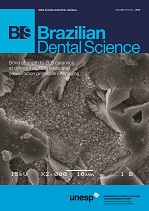Application of E-learning in Dental Radiology Education at undergraduate level –a Systematic Review
DOI:
https://doi.org/10.14295/bds.2019.v22i4.1781Abstract
With the increase in internet technology as well as the electronic content the web-based learning has become the desirable medium in the field of education. In medical, dental and allied health science education, the conventional method involves the use of textbooks, lectures, and images. But trends suggest that a change is poised in this field. Objective: the systematic review aims to evaluate the literature of studies about the application of the e-Learning methods in radiology education at the undergraduate level in comparison to conventional teaching-learning methods. Material and Methods: prominent scientific databases were searched for literature related to the application of e-Learning in undergraduate radiology education. The search keywords used for the search were- E-learning, dental radiology, oral radiology, undergraduate. English language full text of eligible article was systematically reviewed. Results: seven full text articles were obtained after scrutiny of the available literature. Most of the research work was carried out in the past decade and dental schools in different parts of the world. Almost all the studies showed that e-learning was as either equally effective or more effective when compared to conventional teaching in dental radiology. Conclusion: e-learning could be a suitable alternative to conventional teaching-learning method with significant improvement in student attitude and knowledge however, the influence of e-learning in improving the practical or clinical skills of dental radiography is still debatable.
Downloads
Downloads
Published
How to Cite
Issue
Section
License
Brazilian Dental Science uses the Creative Commons (CC-BY 4.0) license, thus preserving the integrity of articles in an open access environment. The journal allows the author to retain publishing rights without restrictions.
=================




























